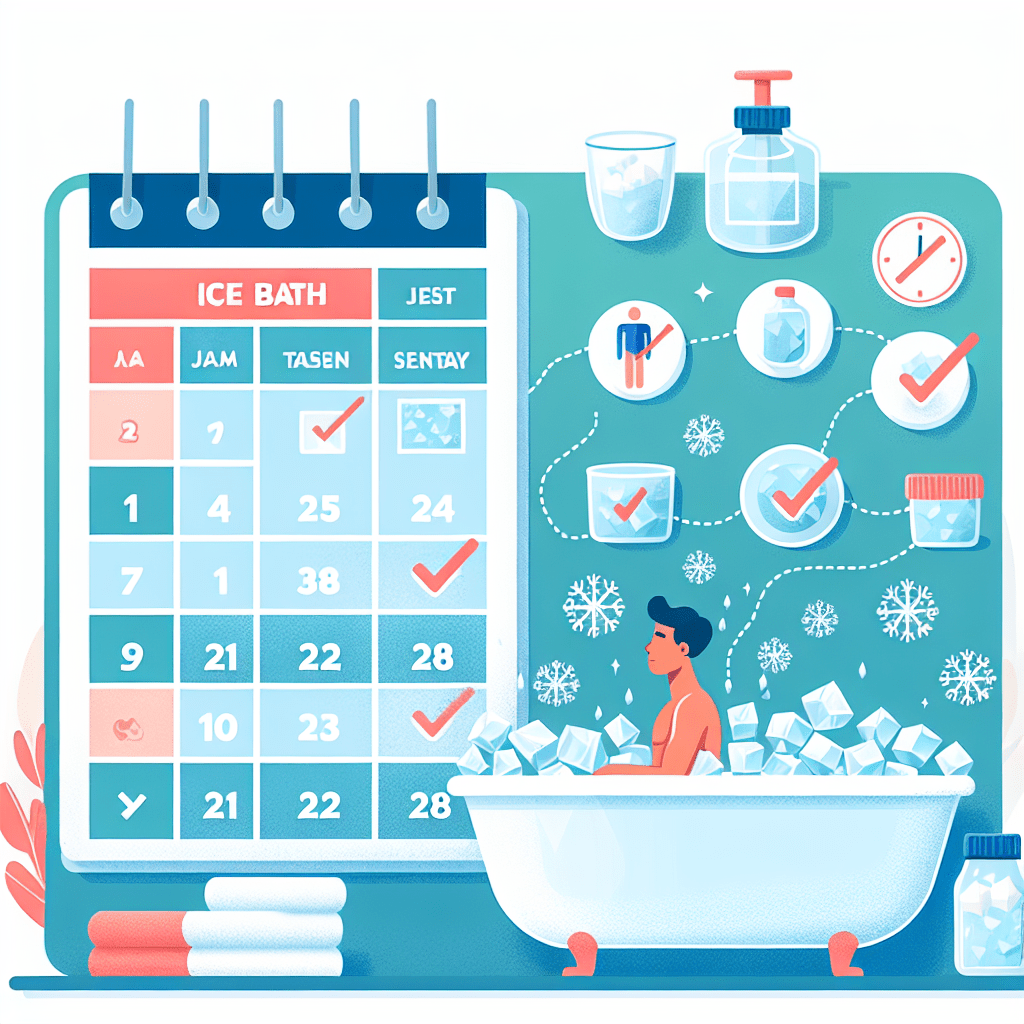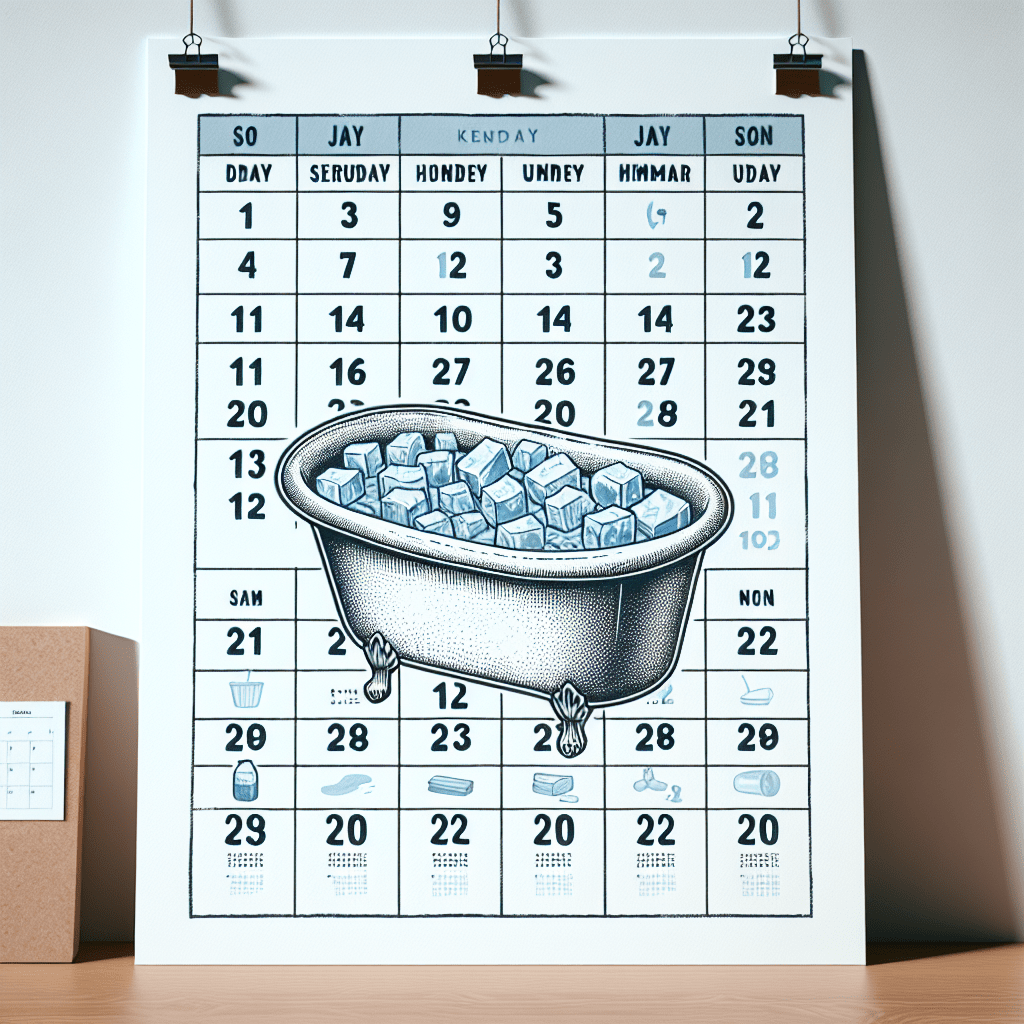Ice Baths: A Weekly Routine for Better Health?

Ice baths have gained increasing popularity in recent years, not just among athletes but also among individuals seeking various health benefits. Dipping into a tub filled with floating ice cubes and chilling cold water can stir up reactions—mainly shock. However, performing this as part of a cold immersion routine can offer excellent physical and psychological benefits.
With the potential for significant benefits, the question becomes how many ice baths a week are needed to achieve the most benefits. The debate around the weekly frequency of ice baths divides experts, with some advocating for it as a regular practice and others touting it as a ritual to use sparingly.
Within the cold therapy community, there are many myths and misconceptions about the potential risks and benefits of ice baths. Many people question the efficacy of ice baths and whether they outweigh the discomfort of drenching oneself in freezing water.
While ice baths and cold water immersion aren’t one-size-fits-all, we aim to highlight ways you can incorporate them into your regular routine, encouraging a holistic approach to health and wellness. After all, shedding light on the practice could indeed inspire better health habits.

Weekly Ice Baths for Optimal Health
The burning question on everyone’s mind is: How many ice baths a week are optimal for health? Unfortunately, it isn’t as straightforward as you’d think. The frequency of ice baths varies depending on individual goals, tolerance, and overall health status.
Benefits of Ice Baths
Ice bath benefits come from the icy sensation you experience when entering the cold water. This shocks the body as it attempts to maintain its body temperature. This dramatic temperature change generates stress that activates various systems within the body, producing beneficial results that contribute to better well-being.
Improved Circulation
Stepping into cold water causes blood vessels to constrict. This reaction reduces blood flow to the extremities. However, it pushes blood to vital organs, such as the heart, lungs, and brain, circulating more oxygen and nutrients in those areas. As the body warms, blood vessels relax, allowing blood to flow normally. This natural response improves cardiovascular health and organ function over time.
Lymphatic System
Similar to the circulation system, cold water immersion stimulates the lymphatic system. When the lymphatic system is triggered, it helps remove toxins from the body, maintain healthy fluid levels, and support the immune system. It works alongside the circulatory system.
Metabolic rate
Cold water therapy may also affect metabolism. As the body strives to counter the sharp drop in external temperature, the metabolic rate increases, initiating thermogenesis. This can result in burning extra calories and aid in weight management.
Immune Response
The increased circulation and oxygen in the blood can lead to the production of more white blood cells. These blood cells serve as our body’s primary defense mechanism against illnesses as they fight foreign entities in the body. One study showed that a group of men who regularly used cold water therapy to boost their immune system took fewer sick days overall than those who didn’t.
Stress Relief
Cold water provokes the release of stress hormones such as adrenaline and cortisol in the body. These hormones generate a sense of alertness. Regular exposure to cold water can fine-tune the body’s stress response over time, making it more efficient at reducing the negative effects of prolonged stress exposure.
Enhanced Mood
The invigorating shock of a cold plunge not only awakens the senses but activates the production of mood-enhancing endorphins. These endorphins lead to a heightened sense of well-being, increased optimism, and a positive outlook on life. For many, this mood boost is a natural antidote to the blues, making cold soaks a therapeutic ritual for both the body and the mind.
Inflammation and Pain
Thanks to the vasoconstriction of the blood vessels from the cold water, ice baths can aid in reducing inflammation and pain. Cold water therapy can reduce pain and discomfort, whether it’s sore muscles from a workout or joint pain from an injury. It can also help muscles recover faster and reduce joint swelling.

Why do Athletes Take Ice Baths?
Many studies have focused on the impact of regular cold immersions on athletes’ physical health and performance. Elite athletes often incorporate an ice bath into their recovery routine to reduce inflammation post-workout.
Delayed Onset Muscle Soreness
Studies conducted on athletic performance show a definite reduction in delayed-onset muscle soreness (DOMS) following regular ice baths. A therapeutic ice bath post-workout can expedite muscle recovery and reduce soreness, helping athletes get back to their training schedules more quickly.
The Balancing Act: Helpful vs Hurtful
Although ice baths can be invigorating and beneficial, anything in excess can cause harm. Understanding the balance between getting the most out of your ice baths and avoiding potential tissue damage or other adverse effects is crucial.
Cold Bath Duration
The duration of cold exposure in ice baths is crucial. How long to stay in an ice bath will vary from person to person. Cold water swimmers are mandated not to exceed 30 minutes of cold exposure per swim. Experts suggest, for an average person, a maximum ice bath time of 10-15 minutes per session.
Risks Associated with the Excessive Cold
Are ice baths dangerous? There are risks associated with cold temperatures, such as a sudden drop in body temperature, known as hypothermia, frostbite, and shock to the nervous system. Therefore, it is important to listen to your body and exit the ice bathtub immediately.
Extreme cold can be detrimental to those with certain health conditions. So, individuals considering regular ice baths should consult their healthcare provider, particularly those suffering from cardiovascular diseases or other chronic conditions.

Misconceptions About Cold Water Therapy
While personal testimonies support ice baths, distinguishing physical changes from placebo effects is crucial. Some enthusiastic ice bathers may attribute several improvements to ice baths, but not all claims are scientifically proven. While studies have shown how ice baths can boost recovery, a widespread misconception is that they’re a one-stop solution for all post-workout pain. Professionals warn against using ice baths to replace other proven recovery methods like proper nutrition and rest. Hence, it is advisable to approach and incorporate this routine with caution.
How Many Ice Baths a Week?
Perhaps one of the most important aspects to consider while creating your ice bath routine is the frequency. The purpose should be to find what works for an individual’s needs while reducing risks.
Athletes might need an ice bath for recovery after intense workouts. At the same time, someone with chronic inflammatory conditions might benefit from a weekly ice bath to manage symptoms. Therefore, it’s crucial to recognize that the recommended number of hydrotherapy sessions weekly will differ among people.
Remember that more doesn’t necessarily mean better. Cold water therapy is supposed to offer a brief stimulating shock to your system, not add stress and strain. When creating an optimal bath schedule, consider factors such as physical condition, tolerance level, need, and personal anecdotal benefits.
Personalized Ice Bath Routine
Once you’ve understood the science behind ice baths and their potential benefits, implementing a personalized routine is the next step. Let’s explore how to start this journey, tweak the ice bath frequency according to individual needs, and complement baths with other healthy practices.
How to Take an Ice Bath
For beginners, jumping right into a bath brimming with icy water might be more of a shock than a therapeutic experience. Here are the steps to take in this new regimen.
Beginning Slowly
Before making an ice bath at home or investing in an ice bathtub, start slowly by taking colder-than-usual showers. Then, as the body adjusts, alternate between cold and warm showers before moving to a full cold shower. Build an ice bath routine after allowing the body to adapt to regular interaction with cold water.
- Length of Ice Baths
- The time spent in cold water should also progressively increase. A few minutes might be enough to stimulate the desired stress response. As the body adapts, cold bath lengths can extend. But don’t push the body too hard too quickly, as it could lead to unwanted risks.
- Ice Bath Frequency
- Adjusting the frequency and duration of ice baths will depend on age, health, fitness level, and need. Here are some reasons why there is no standard frequency of ice baths for better health.
- Personal Cold Tolerance
- A person’s cold tolerance can determine if the body requires only a few minutes in the cold to reap the benefits of the initial shock, or if it needs longer to feel the full effect. A low cold tolerance can also increase the risk of hypothermia.
- Pre-existing Conditions
- Those with conditions such as cardiovascular disease should speak to a medical professional to determine the best frequency, duration, and even temperature of an ice bath to create a safe and beneficial routine.
- Workout or Fitness Routines
- Exercise routines affect weekly ice bath frequency, especially for those using cold immersion therapy for muscle recovery. The more workouts per week, the possibility of more therapy sessions.
- Sleep Patterns
- Sleep impacts weekly ice bath routines, and bath routines impact sleep. Working out in the evening may mean no time for an ice bath recovery session. While cold immersion therapy may improve sleep, a session too close to bedtime may make it difficult to fall asleep quickly.
Cold Water Immersion Safety
Monitoring the body’s responses is vital. Signs such as uncontrollable shivering, numbness, or a drop in body temperature could indicate hypothermia, in which case the session should stop immediately. People react differently to the cold, so personalized routines are important. Ice bath safety should remain a priority for everyone.
Scheduling Baths for Maximum Effectiveness
The time chosen to take an ice bath significantly affects its efficiency. If using ice baths for recovery after workouts, taking the bath within 24 hours will offer the most relief. Similarly, if battling insomnia, cold showers or baths before bedtime can be beneficial. A weekly ice bath can be incorporated into any health regimen, depending on personal needs and goals.

Ice Baths for Better Health
So, the fundamental question is, “Are ice baths an effective weekly ritual for better health?” The all-encompassing answer is “yes” and “no.” The potential benefits and efficacy of ice baths differ greatly among individuals. It depends on a person’s needs, health objectives, and ability to fine-tune their routine.
While rising evidence leans towards the therapeutic benefits of controlled cold exposure, with many individuals attesting to the invigorating effects of regular cold immersions, it isn’t black and white. The “cold” truth is that this practice hinges on a delicate balance that requires careful consideration of the ice bath frequency, duration, individual tolerance, and overall mental and physical health. Both its invigorating boost and potential risks need adequate respect.
Whether integrating weekly ice baths into a health and wellness routine or not, they should never be considered a substitute for the fundamentals of good health. Always take a proactive approach to mental, physical, diet, exercise, and sleep. Ice baths are another piece of the puzzle that is a person’s overall well-being.
Cold water immersion and ice baths may serve as occasional treatments for some and regular staples for others. When deciding to add this therapy to a wellness routine, it’s essential to understand the benefits versus the risks and to adapt and stay safe while tailoring this method to one’s needs.


